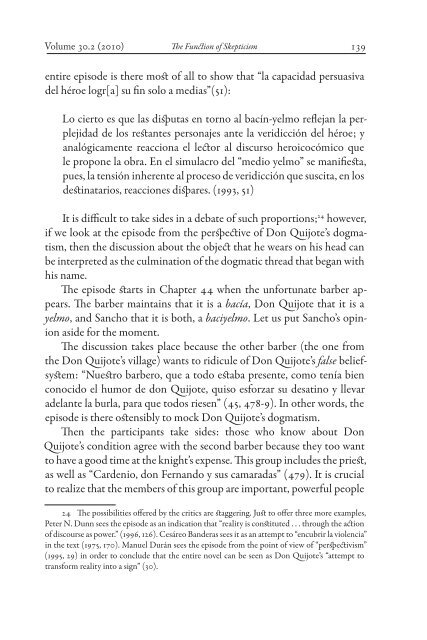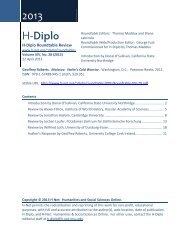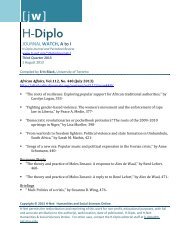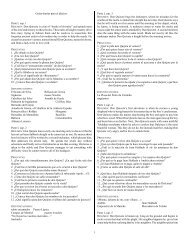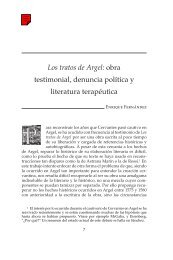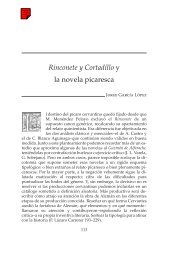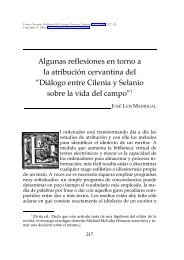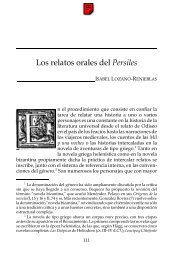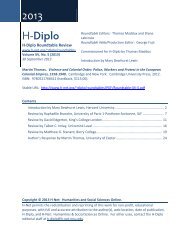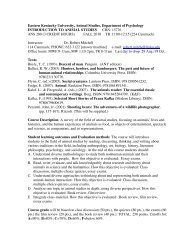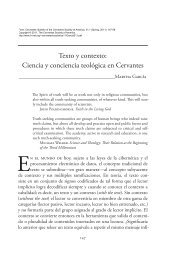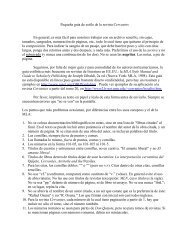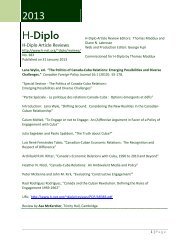The Function of Skepticism in Part I of Don Quijote - H-Net
The Function of Skepticism in Part I of Don Quijote - H-Net
The Function of Skepticism in Part I of Don Quijote - H-Net
Create successful ePaper yourself
Turn your PDF publications into a flip-book with our unique Google optimized e-Paper software.
Volume 30.2 (2010) <strong>The</strong> <strong>Function</strong> <strong>of</strong> <strong>Skepticism</strong><br />
139<br />
entire episode is there most <strong>of</strong> all to show that “la capacidad persuasiva<br />
del héroe logr[a] su f<strong>in</strong> solo a medias”(51):<br />
Lo cierto es que las disputas en torno al bacín-yelmo reflejan la perplejidad<br />
de los restantes personajes ante la veridicción del héroe; y<br />
analógicamente reacciona el lector al discurso heroicocómico que<br />
le propone la obra. En el simulacro del “medio yelmo” se manifiesta,<br />
pues, la tensión <strong>in</strong>herente al proceso de veridicción que suscita, en los<br />
dest<strong>in</strong>atarios, reacciones dispares. (1993, 51)<br />
It is difficult to take sides <strong>in</strong> a debate <strong>of</strong> such proportions; 24 however,<br />
if we look at the episode from the perspective <strong>of</strong> <strong>Don</strong> <strong>Quijote</strong>’s dogmatism,<br />
then the discussion about the object that he wears on his head can<br />
be <strong>in</strong>terpreted as the culm<strong>in</strong>ation <strong>of</strong> the dogmatic thread that began with<br />
his name.<br />
<strong>The</strong> episode starts <strong>in</strong> Chapter 44 when the unfortunate barber appears.<br />
<strong>The</strong> barber ma<strong>in</strong>ta<strong>in</strong>s that it is a bacía, <strong>Don</strong> <strong>Quijote</strong> that it is a<br />
yelmo, and Sancho that it is both, a baciyelmo. Let us put Sancho’s op<strong>in</strong>ion<br />
aside for the moment.<br />
<strong>The</strong> discussion takes place because the other barber (the one from<br />
the <strong>Don</strong> <strong>Quijote</strong>’s village) wants to ridicule <strong>of</strong> <strong>Don</strong> <strong>Quijote</strong>’s false beliefsystem:<br />
“Nuestro barbero, que a todo estaba presente, como tenía bien<br />
conocido el humor de don <strong>Quijote</strong>, quiso esforzar su desat<strong>in</strong>o y llevar<br />
adelante la burla, para que todos riesen” (45, 478-9). In other words, the<br />
episode is there ostensibly to mock <strong>Don</strong> <strong>Quijote</strong>’s dogmatism.<br />
<strong>The</strong>n the participants take sides: those who know about <strong>Don</strong><br />
<strong>Quijote</strong>’s condition agree with the second barber because they too want<br />
to have a good time at the knight’s expense. This group <strong>in</strong>cludes the priest,<br />
as well as “Cardenio, don Fernando y sus camaradas” (479). It is crucial<br />
to realize that the members <strong>of</strong> this group are important, powerful people<br />
24 <strong>The</strong> possibilities <strong>of</strong>fered by the critics are stagger<strong>in</strong>g. Just to <strong>of</strong>fer three more examples,<br />
Peter N. Dunn sees the episode as an <strong>in</strong>dication that “reality is constituted . . . through the action<br />
<strong>of</strong> discourse as power.” (1996, 126). Cesáreo Banderas sees it as an attempt to “encubrir la violencia”<br />
<strong>in</strong> the text (1975, 170). Manuel Durán sees the episode from the po<strong>in</strong>t <strong>of</strong> view <strong>of</strong> “perspectivism”<br />
(1995, 29) <strong>in</strong> order to conclude that the entire novel can be seen as <strong>Don</strong> <strong>Quijote</strong>’s “attempt to<br />
transform reality <strong>in</strong>to a sign” (30).


